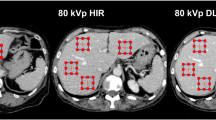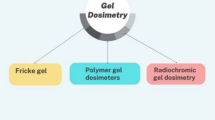Abstract
The Computed Tomography Dose Index (CTDI) is an indicator for dose management in computed tomography (CT), but has limited use for patient dosimetry. To evaluate the patient dose, the size-specific dose estimate (SSDE), reported by the American Association of Physics in Medicine task groups 204, 220, and 293, must be calculated by the CTDIvol(z) displayed on the CT console, and the conversion factor f(D(z)) from the effective diameter (DEff) or water equivalent diameter (Dw). However, no reports have verified the appropriateness of using the 320-mm diameter phantom for dose assessment in CT examinations involving the lower limbs. Therefore, we validated a new method for evaluating the SSDE(z) of the lower limbs, using two 160-mm diameter phantoms instead of the 320-mm diameter phantom. The CTDIvol(z) obtained from Monte Carlo (MC) simulation study was reliable because they were almost the same as obtained in a dosimetry study. The conversion factor f (D (zl.l.)) for the lower limbs was evaluated based on the CTDIvol(z) obtained by MC simulation performed using two polymethyl methacrylate cylinder phantoms of 160-mm diameter. The MC simulation was performed by the International Commission on Radiological Protection publication 135 reference adult phantom and was used to evaluate the absorbed dose of the pelvis, thighs, knees, and ankles. The dose showing the greatest difference was the thighs, which was 8.3 mGy (16%) lower than the absorbed dose. Thus, the SSDE (zl.l.) could be estimated from the \({\mathrm{CTDI}}_{\mathrm{vol}}^{320}\left(\mathrm{z}\right)\) displayed on the CT scanner console.





Similar content being viewed by others
Data availability
The datasets collected and/or analyzed in the current study are available from the corresponding author upon reasonable request.
Code availability
ImPACT MC Version 1.60 (CT imaging GmbH, Erlangen, Germany) Monte Carlo simulation software.
References
Food and Drug Administration. Diagnostic x-ray systems and their major components. 1984; United States FDA Code of Federal Regulations, 21 CFR 1020.33, US Nuclear Regulatory Commission, US Govt. (Washington DC: FDA).
International Electrotechnical Commission. International Standard. Medical Electrical Equipment–Part 2–44: Particular Requirements for the Safety of X-ray Equipment for Computed Tomography. 2009; IEC 60601–2–44 Ed3 Amendment 1. (Geneva, Switzerland: IEC).
International Commission on Radiological Protection. The 2007 Recommendations of the International Commission on Radiological Protection. Ann ICRP. 37 (2–4) 2007; ICRP Publication no. 103.
McCollough CH, Leng S, Yu L, Cody DD, Boone JM, McNitt-Gray MF (2011) CT dose index and patient dose: they are not the same thing. Radiology 259:311–316. https://doi.org/10.1148/radiol.11101800
American Association of Physicists in Medicine. Size-Specific Dose Estimates (SSDE) in Pediatric and Adult Body CT Examinations. AAPM Task Group 204 2011; AAPM Report no. 204.
American Association of Physicists in Medicine. Use of Water Equivalent Diameter for Calculating Patient Size and Size-Specific Dose Estimates (SSDE) in CT. AAPM Task Group 220 2014; AAPM Report no. 220.
American Association of Physicists in Medicine. Size-Specific Dose Estimate (SSDE) for Head CT. AAPM Task Group 293 2019; AAPM Report no. 293.
International Electrotechnical Commission. Methods for Calculating Size Specific Dose Estimates (SSDE) for Computed Tomography. 2019; International Standard of IEC 62985. (Geneva, Switzerland: IEC).
Keller G, Götz S, Kraus MS, Grünwald L, Springer F, Afat S (2021) Radiation dose reduction in CT torsion measurement of the lower limb: Introduction of a new ultra-low dose protocol. Diagnostics (Basel) 11:1209. https://doi.org/10.3390/diagnostics11071209
Keller G, Afat S, Ahrend M-D, Springer F (2021) Diagnostic accuracy of ultra-low-dose CT for torsion measurement of the lower limb. Eur Radiol 31:3574–3581. https://doi.org/10.1007/s00330-020-07528-8
Qi L, Meinel FG, Zhou CS, Zhao YE, Schoepf UJ, Zhang LJ, Lu GM (2014) Image quality and radiation dose of lower extremity CT angiography using 70 kVp, high pitch acquisition and sinogram-affirmed iterative reconstruction. PLoS ONE 9:e99112. https://doi.org/10.1371/journal.pone.0099112
Inoue Y, Itoh H, Nagahara K, Takahashi Y (2020) Estimation of radiation dose in ct venography of the lower extremities: phantom experiments using different automatic exposure control settings and scan ranges. Radiat Prot Dosimetry 188:109–116. https://doi.org/10.1093/rpd/ncz265
International Commission on Radiological Protection. Managing Patient Dose in Multi-Detector Computed Tomography. Ann ICRP. 37(1). 2007; ICRP Publication no. 102.
European Guidelines. Quality Criteria for Computed Tomography. 1997; EUR 16262.
Inoue Y, Yonekura Y, Nagahara K et al (2022) Conversion from dose-length product to effective dose in computed tomography venography of the lower extremities. J Radiol Prot 42:011521. https://doi.org/10.1088/1361-6498/ac49d6
International Commission on Radiological Protection. Conversion Coefficients for use in Radiological Protection against External Radiation. Ann ICRP. 26 1996; ICRP Publication no. 74.
Kobayashi M, Haba T, Suzuki S, Nishihara Y, Asada Y, Minami K (2020) Evaluation of exposure dose in fetal computed tomography using organ-effective modulation. Phys Eng Sci Med 43:1195–1206. https://doi.org/10.1007/s13246-020-00921-z
International Commission on Radiological Protection. Adult Mesh-type Reference Computational Phantoms. Ann ICRP 49(3) 2020; ICRP Publication no 145.
Kevin T, Li Ke (2020) Accuracy of weighted CTDI in estimating average dose delivered to CTDI phantoms: an experimental study. Med Phys 47:6484–6499. https://doi.org/10.1002/mp.14528
Fukuda A, Pei-Jan P, Kosuke M, Miyata T (2014) Evaluation of gantry rotation overrun in axial CT scanning. J Appl Clin Med Phys 15:229–234. https://doi.org/10.1120/jacmp.v15i5.4901
Leitz W, Axelsson B, Szendrö G (1995) Computed tomography dose assessment - a practical approach. Radiat Prot Dosimetry 57:377–380. https://doi.org/10.1093/rpd/57.1-4.377
Haba T, Kobayashi M, Koyama S (2019) Size-specific dose estimates for various weighting factors of CTDI equation. Australas Phys Eng Sci Med 43:155–162. https://doi.org/10.1007/s13246-019-00830-w
American Association of Physicists in Medicine. Comprehensive Methodology for the Evaluation of Radiation Dose in X-Ray Computed Tomography. AAPM Task Group 111 2010; AAPM Report no. 111.
American Association of Physicists in Medicine. The Design and Use of the ICRU/AAPM CT Radiation Dosimetry Phantom: AAPM Task Group 200 2020; AAPM Report no. 200.
Acknowledgements
We would like to thank Editage (www.editage.com) for English language editing.
Funding
The authors declare that no funds, grants, or other support were received during the preparation of this manuscript.
Author information
Authors and Affiliations
Contributions
YM measured computed tomography dose index. YN performed the MC simulation and evaluated doses with TH. YA and SK were major contributors to writing the manuscript. All authors read and approved the final manuscript.
Corresponding author
Ethics declarations
Competing interests
The authors have no relevant financial or non-financial interests to disclose.
Ethical approval
This is an observational study. No ethical approval is required.
Consent to participate
This is an observational study. No ethical approval is required.
Consent to publish
No ethical approval is required.
Additional information
Publisher's Note
Springer Nature remains neutral with regard to jurisdictional claims in published maps and institutional affiliations.
Rights and permissions
Springer Nature or its licensor (e.g. a society or other partner) holds exclusive rights to this article under a publishing agreement with the author(s) or other rightsholder(s); author self-archiving of the accepted manuscript version of this article is solely governed by the terms of such publishing agreement and applicable law.
About this article
Cite this article
Kobayashi, M., Nishihara, Y., Haba, T. et al. SIZE-specific dose estimate for lower-limb CT. Phys Eng Sci Med 45, 1183–1191 (2022). https://doi.org/10.1007/s13246-022-01186-4
Received:
Accepted:
Published:
Issue Date:
DOI: https://doi.org/10.1007/s13246-022-01186-4




